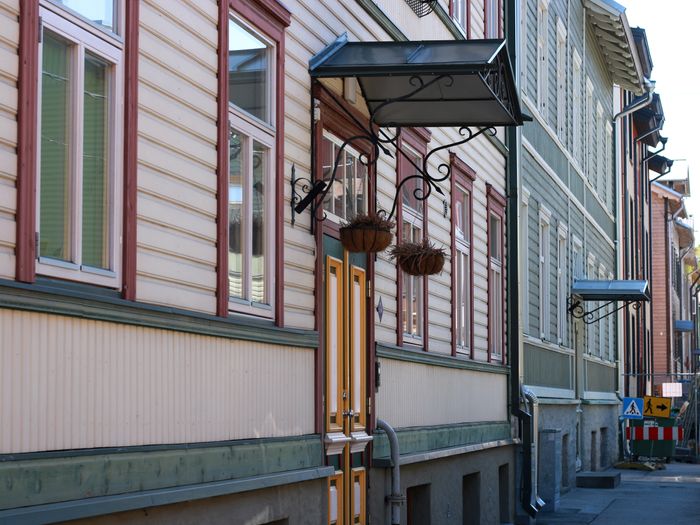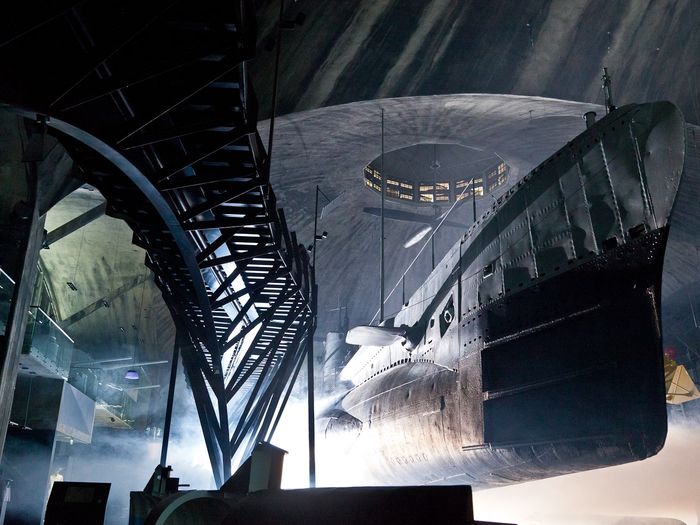
Kalamaja, Telliskivi, and Noblessner – industrial heritage and bohemian charm
25.08.2020
Kalamaja, along with Telliskivi and Noblessner, is a lovely neighbourhood in Tallinn, just next to the Old Town and the Balti Jaam railway station. Loved for its relaxed atmosphere, colourful wooden buildings, and its lively culture and nightlife, the area draws in locals and visitors from around the city.
Once a working-class district, Kalamaja has now become the residence of choice for young, creative types making the most out of its industrial legacy: entire factory complexes have been transformed into museums, cultural venues, shops, restaurants and bars. The area’s former wooden living quarters are dotted with charming bakeries and cafés.
In Kalamaja, you will find the city’s impressive maritime museum, the Seaplane Harbour, and the Stockholm-originated world-class photography centre Fotografiska Tallinn. For families, Energy Discovery Centre is also definitely worth a visit. Noblessner Seafront District is home to the high-tech Proto Invention Factory and the Kai Art Centre. Most of these museums are located in former factory and harbour buildings, taking full advantage of their impressive 19th- and 20th-century industrial interiors.
Historical background
Throughout most of Tallinn’s history, Kalamaja served as the town’s main fishing harbour. In fact, 'Kalamaja' literally means 'fish house' in Estonian, and starting from the 14th century, the area was traditionally dominated by fishermen and fishmongers.
Everything changed in 1870, however, when Tallinn was connected to St. Petersburg by railroad. Suddenly large factories started to sprout up in this part of town, bringing with them an influx of thousands of new workers.
The wooden houses built to accommodate the factory workers along with the different industrial buildings are now part of Kalamaja's architectural legacy and are what gives the neighbourhood its unforgettable charm.
The most architecturally unique of these are called 'Tallinn Houses'. Built in the 1920s and 30s, these two- to three-storey apartment houses consist of two symmetrical, wooden wings separated by a central stone staircase. There are about 500 of these in the city today.
Kalamaja’s colourful wooden houses
The heart of Kalamaja is filled with colourful wooden houses with bright panel doors. These are the former living quarters of the area’s factory workers, mainly dating from the end of the 19th and the beginning of the 20th centuries, now homes to young professionals and families.

To see Kalamaja’s (Instagram-worthy) colours in full bloom, head to the streets of Valgevase, Kalju, Kungla, Vana-Kalamaja and Niine. Some of the neighbourhood’s other sights include the neo-gothic Kalju Baptist Church and the Kalamaja Park, a former cemetery transformed into a park in the 1960s, now a lush, relaxing area for kids and adults alike.
Eat and drink in Kalamaja
Kalamaja is home to a selection of bars, restaurants, and street food places. The area also has many charming cafés and bakeries, each with its own signature feel.
How to get to Kalamaja?
This colourful Kalamaja area is located just a short stroll away from the Old Town, across the tracks of the Balti Jaam railway station. You can also take the tram (1 or 2, stop Telliskivi) or bus (3, stop Kalamaja) from the city centre.
Telliskivi Loomelinnak (Telliskivi Creative City)
Telliskivi Loomelinnak or Telliskivi Creative City (Telliskivi 60) is a collection of former factory and railway buildings transformed into a centre for creative enterprises: an entire quarter filled with offbeat eateries, trendy cafés, and hip bars along with design, antique and vintage shops. Telliskivi is also home to the internationally renowned photograpy museum Fotografiska Tallinn and several event venues, such as Erinevate Tubade Klubi, that regularly hosts concerts, parties, conferences and other performances.
The Creative City is also home to many regular outdoor and community events, such as the Telliskivi Flea Market (every Saturday), Street Food Festival (in June) and the Telliskivi Flea Market Festival (in August).
Eat and drink in Telliskivi
When in Telliskivi, do like the locals and enjoy a meal in one of the many restaurants and cafés the place has to offer. For nourishment on the go, stop by the Depoo street food area, right next to Telliskivi’s main entrance, across the railway tracks. The food stands include Peatus – a pair of original Moscow-Tallinn train carriages that have been turned into a café and nightclub.
How to get to Telliskivi?
Telliskivi Creative City is located within walking distance of the Old Town – simply follow the direction of the railway tracks past the Balti Jaam market. You can also take the tram (1 or 2, stop Telliskivi) from the city centre.
Seafront: the Seaplane Harbour
Kalamaja has made an art form out of transforming factory buildings into cultural institutions and museums. One of the first things you notice on the border of the Old Town is the brick chimney of Kultuurikatel, a former power station, now home to Tallinn’s Creative Hub and some of the coolest parties and fairs in town. In the same complex, you will also find the Energy Discovery Centre for science-minded families, and the EKKM, an alternative, contemporary exhibition space.
If you appreciate fresh seafood, you should visit the area on Saturday mornings when the local fish market opens its doors at the fishing port on Kalaranna. The market specialises in fish caught in local waters or grown by local fishermen.
A short walk away, you will find the Seaplane Harbour (Lennusadam) maritime and military museum. Located in seaplane hangars from the beginning of the 19th century, it is definitely worth a visit (or two). Be sure to plan at least a couple of hours to take in the impressive interiors and the unique exhibits, including a life-size submarine from the 1930s and several interactive simulators.

Outside, you can tour historic ships, including the world’s largest steam-powered icebreaker, Suur Tõll. The Seaplane Harbour is also the primary location of Tallinn’s annual maritime festival (in July).
Eat and drink at the seafront
How to get to the seafront?
The Creative Hub and the Energy Discovery Centre are located right next to the Old Town and the port. The best way to visit the Seaplane Harbour is either by strolling along the street of Kalaranna (with an added benefit of glimpses of the Tallinn bay) or by taking a bus (73, stop Lennusadam) from the city centre.
Noblessner Seafront Quarter
Named after its founders, businessmen Emanuel Nobel (nephew of Alfred Nobel) and Arthur Lesner, the Noblessner Seafront Quarter dates back to the beginning of the 20th century. Formerly famous for building submarines for the Russian Empire, the factory was later used as a shipyard.
Today, the Noblessner Seafront Quarter is an up-and-coming city space complete with a port, a restaurant with a Michelin-starred head chef, a top-class brewery, an art-café and the flagship store of one of Estonia’s most beloved home decor brands, Shishi – to name a few places.
For families and curious adults, the Proto Invention Factory is a must see: the museum uses virtual reality to bring to life game-changing inventions from the mid-19th to the early 20th centuries. On the seafront you will find Kai, a contemporary art centre housing gallery spaces and restaurants.
Eat, drink, and shop in Noblessner
How to get to Noblessner?
Bus number 73 takes you directly from the city centre to the heart of the quarter (stop Noblessneri) while bus number 3 stops a bit farther (stop Volta). If you enjoy walking, follow Kalaranna Street by the seaside or stroll through the colourful streets of Kalamaja. Either way, it should be about a 30-minute walk from the Old Town (picture and cake stops not included).
Get more information on Kalamaja, Telliskivi, and Noblessner
Download our detailed map of Kalamaja. If needed, our Tourist Information Centre can always advise you on personalised walking routes.

















